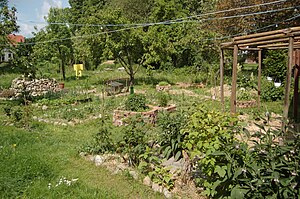
As a wholistic, systems-based design approach, permaculture often takes very different approaches compared to conventional institutions or enterprises.
Agriculture[edit | edit source]
Conventional agriculture and permaculture can often seem to be extreme opposites. But even when it comes to small-scale organic operations, agricultural systems that apply permaculture design are quite distinct from those that do not. Permaculture emphasizes building connections between various elements in a system. This might look like shrubs planted throughout a livestock pasture, which give the livestock shady resting places and also serve as forage for migratory birds. Permaculture also focuses on working with the contour of the landscape, instead of creating straight lines. Thus to the untrained eye, a permaculture site might appear chaotic.
Darren Doherty disagrees with the common view in agronomy that greater than 2% carbon "robs the crop of nitrogen". He sees this view as "dangerous" because it limits carbon sequestration, thereby impacting climate change.[1]
Economics[edit | edit source]
Many people who become active in permaculture continue to maintain their existing stance on economics, whether that be liberal capitalism, libertarian capitalism, socialism, or gift economics. There are many economic ideas within permaculture which might be reconciled or synthesized with these approaches to economics.
Bill Mollison and Ethan Roland have proposed ways of looking at resources/assets that differ with those of other economic theories. Permaculture designers often try to keep flows circulating within a system for as long as possible. Thus permaculturists might try to keep many economic transactions within a local economy, as opposed to other economic approaches that might focus on regional, national, or international exchange.
Soil hydrology[edit | edit source]
Darren Doherty states that soil conservation science tends to operate with the goal of removing water from the soil. Permaculture designs in many contexts (though not all) prefer to retain water in or on a given landscape for as along as possible. Doherty states that in Australia, rivers are often managed to keep them flowing all year, even in cases where these rivers historically dried up in Summer.[2]
References[edit | edit source]
- ↑ Permaculture Voices podcast, episode 115, 26:40-27:30, http://www.permaculturevoices.com/115
- ↑ Permaculture Voices podcast, episode 115, 27:45-30:40, http://www.permaculturevoices.com/115